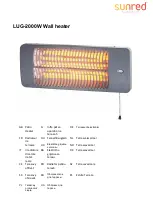
4.2 Start- up
Before lighting the water heater
•
Check the tightness of the gas system.
•
Fill the water system and make sure all air contained in the water heater and system
has been vented .
•
Make sure there are no water leaks in the system or unit.
•
Check correct connection of the electrical system and efficiency of the earthing sys-
tem.
•
Make sure the gas pressure value for heating is that required .
•
Make sure there are no flammable liquids or materials in the immediate vicinity of
the water heater.
Checks during operation
•
Switch the unit on.
•
Make sure the fuel circuit and water systems are tight.
•
Check the efficiency of the flue and air/fume ducts while the water heater is working.
•
Make sure the gas valve modulates correctly in the heating and hot water production
stages.
•
Check proper lighting of the water heater by doing several tests, turning it on and off
with the room thermostat or remote control.
•
Make sure the fuel consumption indicated on the meter matches that given in the
technical data table on cap. 5.
4.3 Maintenance
Periodical check
To ensure correct operation of the unit over time, have qualified personnel carry out a
yearly check, providing for the following:
•
The control and safety devices (gas valve, flowmeter, etc.) must work properly.
•
The fume exhaust circuit must be perfectly efficient.
•
The air/fume terminal and ducts must be free of obstructions and leaks
•
The burner and exchanger must be clean and free of deposits. For cleaning, do not
use chemical products or wire brushes.
•
The electrode must be properly positioned and free of scale.
fig. 12 - Electrode positioning
•
The gas and water systems must be tight.
•
The gas flow and pressure must correspond to that given in the respective tables.
4.4 Troubleshooting
Diagnostics
The water heater has an advanced self-diagnosis system. In case of a fault in the unit,
the display will flash together with the fault symbol (detail 11 - fig. 1) indicating the fault
code.
There are faults that cause permanent shutdown (marked with the letter "
A
"): to restore
operation just press the RESET button (detail 6 - fig. 1) for 1 second or RESET on the
optional remote timer control if installed; if the water heater fails to restart, it is necessary
to eliminate the fault .
Other faults (marked with the letter “
F
”) cause temporary shutdowns that are automati-
cally reset as soon as the value returns within the water heater's normal working range
List of faults
Table. 6
3
±
0,5
=
=
Fault
code
Fault
Possible cause
Cure
A01
No burner ignition
No gas
Check the regular gas flow to the
water heater and that the air has been
eliminated from the pipes
Ignition/detection electrode fault
Check the wiring of the electrode and
that it is correctly positioned and free
of any deposits
Faulty gas valve
Check gas valve and replace it if
necessary
Gas valve wiring disconnected
Check the wiring
Ignition power too low
Adjust the ignition power
A02
Flame present signal with
burner off
Electrode fault
Check the ionisation electrode wiring
Card fault
Check the card
A03
Overtemperature
protection activation
DHW sensor damaged
Check the correct positioning and
operation of the DHW sensor
No water circulation
Check the flowswitch
F04
Card parameter fault
Wrong card parameter setting
Check the card parameter and modify
it if necessary
F05
Card parameter fault
Wrong card parameter setting
Check the card parameter and modify
it if necessary
Fan fault
Wiring disconnected
Check the wiring
Faulty fan
Check the fan
Card fault
Check the card
A06
No flame after the ignition
phase
Low pressure in the gas system
Check the gas pressure
Burner minimum pressure setting
Check the pressures
F07
Card parameter fault
Wrong card parameter setting
Check the card parameter and modify
it if necessary
A09
Gas valve fault
Wiring disconnected
Check the wiring
Faulty gas valve
Check the gas valve and replace it if
necessary
F10
DHW sensor 1 fault
Sensor damaged
Check the wiring or replace the
sensor
Wiring shorted
Wiring disconnected
F14
DHW sensor 2 fault
Sensor damaged
Check the wiring or replace the
sensor
Wiring shorted
Wiring disconnected
A16
Gas valve fault
Wiring disconnected
Check the wiring
Faulty gas valve
Check the gas valve and replace it if
necessary
F20
Combustion control fault
Fan fault
Check the fan and fan wiring
Wrong baffle
Check the baffle and replace it if
necessary
Flue obstructed or not correctly
sized
Check the flue
A21
Poor combustion fault
Fault F20 generated 6 times in the
last 10 minutes
See fault F20
F34
Supply voltage under 180V. Electric mains trouble
Check the electrical system
F35
Faulty mains frequency
Electric mains trouble
Check the electrical system
A41
Sensor positioning
DHW sensor disconnected from
pipe
Check the correct positioning and
operation of the sensor
F42
DHW sensor fault
Sensor damaged
Replace the sensor
F50
Gas valve fault
Modulating Operator wiring
disconnected
Check the wiring
Faulty gas valve
Check the gas valve and replace it if
necessary
A51
Poor combustion fault
Inlet/exhaust flue obstruction
Check the flue
SUPREME E TS
5
EN


























